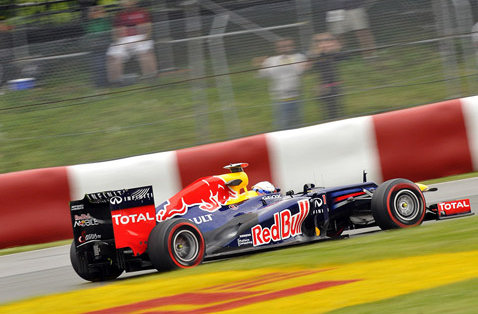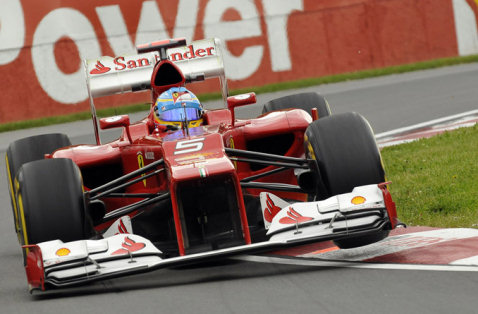The Way It Is/ F1's future in Americaby Gordon Kirby |
 Whatever your view of Formula One you have to be impressed by a form of racing with the strength to organize and enforce an August summer vacation for its teams. There's not only a void of races this month but the F1 factories are actually compelled to shut down for two weeks so that everyone--travelling race team crews and home workforces--are allowed to enjoy a civilized break from today's unrelentingly furious global F1 schedule. It's a treat that must provoke some considerable envy from everyone who works in other forms of racing from NASCAR to the NHRA.
Whatever your view of Formula One you have to be impressed by a form of racing with the strength to organize and enforce an August summer vacation for its teams. There's not only a void of races this month but the F1 factories are actually compelled to shut down for two weeks so that everyone--travelling race team crews and home workforces--are allowed to enjoy a civilized break from today's unrelentingly furious global F1 schedule. It's a treat that must provoke some considerable envy from everyone who works in other forms of racing from NASCAR to the NHRA.
When the F1 world championship resumes at Spa in September there will be nine races to go and each of Fernando Alonso, Mark Webber, Sebastien Vettel, Lewis Hamilton and Kimi Raikkonen have realistic chances of winning this year's championship. Alonso has a solid grip on the mid-season points lead but Webber, Vettel, Hamilton and Raikkonen are separated by only eight points and as often as not each of Red Bull, McLaren and Lotus are able to outpace this year's Ferrari. At this stage the odds appear to favor Alonso who's emerged this year as a stronger force than ever capable of getting more out of his car and tires than his rivals and enjoying a forty-point cushion over Webber at mid-season. This year's Ferrari was off the pace at the beginning of the year and there were dire predictions of Ferrari being an also-ran but the team has made progress, equalling if not exceeding the Red Bulls, McLarens and Lotuses on some circuits. Yet Alonso's superb driving and team leadership has shone through with Felipe Massa struggling to come anywhere near his pace in most races.  © Gary Gold Both Vettel and Webber are capable of winning races and the team will be difficult to beat in the constructors stakes. Vettel remains entirely capable of retaining his championship but he will have to perform more consistently than he has so far this year. Webber has been even less consistent, superb at Monaco and Silverstone, but lukewarm in many other races. Of course, the FIA were all over Red Bull before the summer break leaning on the team for its persistent inventiveness in pushing the limits of the rulebook. Red Bull is being watched like a hawk by the governing body and some cynics suggest it's all about assisting Ferrari as much as restraining Red Bull. Also suffering from inconsistency this year is McLaren who have been very competitive in some races, less so in others. Lewis Hamilton scored a convincing victory in Hungary before the break thanks to a brace of detail improvements and there's talk of more to come. Hamilton remains his own worst enemy, blindingly fast most of the time, but still capable of making mistakes and letting his emotions get the better of him. This is his sixth year in F1 but his immaturity compared to Alonso in particular continues to be his weak point. Meanwhile teammate Jenson Button remains a mystery. Not quite as quick as Hamilton, he's foundered in too many races this year and weakened rather than strengthened the team's attack in the constructors championship. It looks like Hamilton and Button will continue longterm with McLaren but you have to wonder if either of them can provide the team leadership needed to beat the likes of Alonso. The surprise of the year has been the Lotus-Renault team with the returning Kimi Raikkonen and F1 rookie Roman Grosjean. The team started the year well and has made steady progress all season producing cars capable of qualifying up front and racing to win. Raikkonen has shown all of his legendary speed from his days with McLaren and Ferrari while GP2 champion Grosjean has been a revelation often outqualifying his more experienced teammate. They finished an excellent two-three in Hungary ahead of Vettel and Alonso and both drivers look capable of winning before the year is out. Raikkonen could even be a factor in the championship battle. Contrastingly Mercedes has been the disappointment of the year. Aside from Nico Rosberg's win from pole in China the Mercedes operation hasn't shown much this season and both Rosberg and teammate Michael Schumacher have been less than sparkling, mediocre in fact in many races.  © Gary Gold F1's high-revving 2.6 liter V8s will be replaced next year by smaller turbo V6s and it will be interesting to see how the new engine formula takes shape. Currently four engine manufacturers are competing in F1--Ferrari, Mercedes, Renault and Cosworth. In addition to the factory team Ferrari supplies Sauber and Toro Rosso with engines; Renault powers Red Bull, Lotus, Williams and Caterham; Mercedes supplies its factory team, McLaren and Force India; and Cosworth keeps tail-enders Marussia and HRT in the game. As a business F1 continues to evolve. A planned IPO on the Singapore stock exchange was postponed after CVC Capital sold 21% of F1 for $1.6 billion in May to three institutional investors, Waddell & Reid, Black Rock and Norges Bank Investment Management. The first two are US asset managers, the last is Norway's state money manager. A new Concorde Agreement has also been under negotiation this year. The new agreement will last through 2020 and will give the teams a substantial increase doubling their share of F1's profits. Meanwhile there are increasing questions about Bernie Ecclestone's ability to run F1. In June German banker Gerhard Gribbowsky was found guilty in a Munich court of receiving a corrupt payment of $44 million from Ecclestone. Gribbowsky was involved in F1's sale to CVC and Ecclestone has admitted to paying the bribe, claiming he was blackmailed. Gribbowsky is appealing his conviction and it's said Ecclestone may be charged by the German authorities as the case continues to unfold. If so, he could be removed as F1's chief executive but that's something the 81-year old Ecclestone will not let happen without a fierce fight. After an absence of five years F1 returns to America in November this year with the debut of Austin's Circuit of the Americas. The revived United States GP will be the second-last race of the F1 season followed the next weekend by the season-closer at Interlagos in Brazil. A second USGP will be added next year in Weehawken, New Jersey directly across the Hudson River from Manhattan and everyone hopes Austin and Weehawken will buck the tide of failed American F1 venues and become successful, established events. With the Olympics upon us the value of national pride in sports is obvious to all and it's no surprise that F1's TV ratings are at their best these days in countries like Germany, the UK and Spain who have superstars to cheer for in Vettel, Schumacher, Hamilton, Button and Alonso. There's no doubt that for Austin and Weehawken to be truly successful events it's necessary to have at least one competitive American driver in the field.  © Gary Gold To make it happen the promoters at Austin and Weehawken should band together and sell sponsorship for a proper American ladder to Formula One. Such a system has reaped great rewards for Red Bull and that's exactly what's needed--a step-by-step system sponsoring talented young American racers from Formula Ford and Formula 3 up through GP3 and GP2 to F1. The beginnings are there in Jeremy Shaw's excellent Team USA program which has provided valuable help to the budding careers of many young American open-wheel racers. Team USA gives young guys an opportunity to race Formula Fords in the UK and attempt to launch their European careers aimed at F1. What's desperately needed are the massive sponsorship dollars required to move these talented youngsters up the next steps on Europe's professional ladder system. We need a national effort to support guys like Conor Daly, Alex Rossi, et al, and develop a real path for an American driver or two to race in F1. If the new big players in F1 in America are to be successful it's essential for them to invest in making the dream happen of a ladder to F1 for young American racers. |
Auto Racing ~ Gordon Kirby Copyright 2012 ~ All Rights Reserved |
